Keyboard and UltraNav
Like the Lenovo ThinkPad X230, the X1 Carbon has Lenovo's recently revised 6 row keyboard design, and we like it. Ancient keys like SysRq have been banished, and the PrtSc (print screen) key is now at the lower right rather than at the top row. The delete key is at the top right corner where it belongs, just above the oversized backspace key. The roomy Chiclet style keyboard has oversized enter, shift and left control keys. Key travel and tactile feel are superb for such a thin machine. Sculpted keys that aren't too slick or too sticky round out an excellent typing experience. The X1 Carbon and Dell XPS 13 have the best keyboards among Ultrabooks, and we put the ThinkPad at the top.
The keyboard has backlighting: press the Fn and spacebar to toggle two levels of white backlight. Sorry, there's no ThinkLight LED lamp above the display to shine down on the keyboard. Typical of Lenovo, There are dedicated mute and volume buttons above the keyboard along with the ThinkVantage button for assistance and system recovery. The illuminated power button lives at the upper right just above the Fn row and a wireless indicator is beside it. The X1 Carbon has a wireless control slider on the left side.
The UltraNav combined trackpad and TrackPoint is made by Synaptics and they work very well. The trackpad is roomy (37% larger than the original X1's) and responsive for multi-touch, and is optimized for Windows 8 according to Lenovo. The TrackPoint, for those who grew up with IBM's eraser stick pointer, is there in all its glory. The TrackPoint has traditional buttons while the trackpad is the trendy buttonless glass affair. The trackpad gives a pleasing audible and tactile click when you left and right click.
Performance
Unlike the first X1 that employed full mobile CPUs, this is through and through an Ultrabook with ULV (ultra low voltage) CPUs that use less power and generate less heat than full mobile CPUs. Something has to give, and that's performance. While ULV Core i5 and i7 CPUs are more than adequate for productivity and streaming media playback, don't expect them to handle 1080p video production or 4,000 rows of Excel spreadsheet computation like their full mobile brethren.
But for those of us who use ultraportables to get everyday work done on the road, video chat on Skype, social network and kill time watching YouTube and Netflix, the ThinkPad X1 Carbon is all that. With third generation Intel Ivy Bridge CPUs and Intel HD 4000 graphics, the ThinkPad X1 Carbon is your productivity buddy. Lenovo sent us their fastest configuration with a 2.0GHz dual core Intel i7-3667U (Turbo Boost to 3.2 GHz) 4 gigs of DDR3 1333MHz RAM and a SanDisk X100 SSD drive. Our machine benchmarked at the top of the Ultrabook heap on PCMark Vantage, thanks to Lenovo's solid internals and the faster than usual CPU (most Ultrabooks ship with either a 1.7 GHz Core i5 or a 1.9 GHz Core i7). In 3DMark Vantage, the score was average among Ultrabooks with Intel HD 4000 graphics. Since this is a business oriented machine, Lenovo didn't squeeze out extra 3D performance as Toshiba did with their widescreen Toshiba Satellite U845W that's oriented toward multimedia and light gaming.
You can order the machine with 4 or 8 gigs of RAM (soldered on the motherboard, there's no RAM slot) and a 128 or 256 gig SSD. The SanDisk X100 is a very fast MLC NAND SATA3 SSD drive with an mSATA connector. The base model uses the same 1.7GHz Intel Core i5-3317U as nearly all Ivy Bridge Ultrabooks, and Lenovo offers a 1.8GHz Core i5 and the 2.0 GHz Core i7 for more money. The faster Core i5 and the i7 have Intel vPro for secure remote management (important to your IT folks but not the average consumer).
Benchmarks
PCMark Vantage: 12,339
Memories: 6973
TV and Movies: 5176
Gaming: 7494
Music: 15,796
Communications: 12,348
Productivity: 17,371
HDD: 38,071
Windows Experience Index:
Processor: 7.1
RAM: 5.9
Graphics (for Aero): 5.9
Gaming Graphics: 6.4
HDD: 7.9
Benchmark Comparison Table
Wireless Options
The machine ships with Intel Centrino Advanced-N 6205 dual band WiFi 802.11a/b/g/n with vPro. It supports WiFi Direct connections but there's no WiDi software for wireless display. The notebook has ThinkPad (Broadcom) Bluetooth 4.0 and an unlocked Ericsson H5321 GSM 3G SIM card slot (3G on the 850/900/1900/2100MHz bands, ideal for AT&T in the US and any GSM carrier overseas). The laptop can act as a mobile hotspot and rebroadcast its WiFi or 3G connection over WiFi to serve your smartphone, other notebook or tablet.
Battery Life
The Lenovo ThinkPad X1 Carbon has a 45Wh Lithium Ion battery that's sealed inside. As mentioned, there's no external battery slice option to extend runtimes. As a consolation, the machine uses Lenovo's RapidCharge that can charge to 80% in 35 minutes. A full charge takes 1.5 hours and a 90% charge just 45 minutes. Excellent. Lenovo claims up to 6.3 hours on a charge, and in our tests over the course of a week, we averaged 5.4 hours with display brightness set to 50% and WiFi turned on in a mix of productivity and light multimedia tasks. That's at the low end of average for Ultrabooks.
You know that standard Lenovo charger with a barrel tip? Toss it in the trash or sell it on Craigslist. The X1 Carbon uses a new rectangular connector. The charger isn't among the smallest and lightest we've seen with Ultrabooks, but the high output 90w, 20v brick does charge the laptop extremely quickly.
Conclusion
I admit it, the moment I saw the Lenovo ThinkPad X1 Carbon I had a serious crush. That's not wildly unusual for this technologist, but those first crushes often turn to indifference once I put a machine through its paces. The ThinkPad X1 Carbon doesn't disappoint; it's got performance, build quality and a very good high resolution display befitting its sexy design (imagine, "sexy" and "ThinkPad" in the same sentence!). The keyboard is unparalleled among Ultrabooks, and the RapidCharge feature offsets the lack of a battery slice option. Among business ultraportables and Ultrabooks, it's hard to beat the X1 Carbon. Its only serious competitors are Lenovo's own ThinkPad X230 and the Sony Vaio S 13.3 and Vaio Z (all with more powerful CPUs). For those considering a consumer oriented machine, the Asus Zenbook Prime UX31A with its 1080p IPS display is hard to beat, but the Lenovo wins for build and quality components.
List Price: Starting at $1,399
Website: www.lenovo.com |
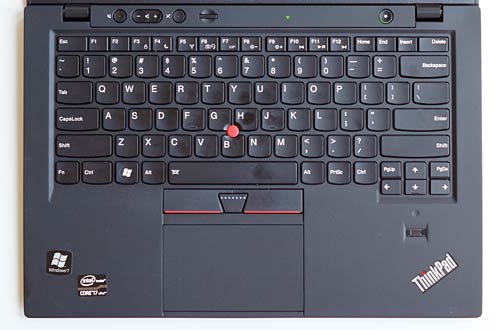
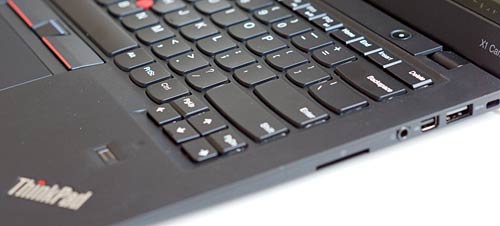
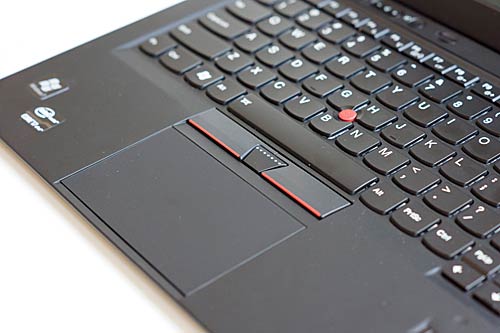
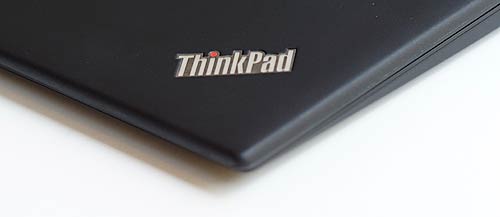
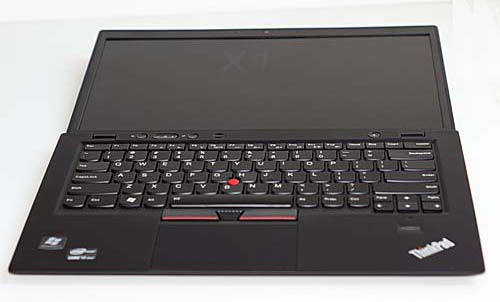
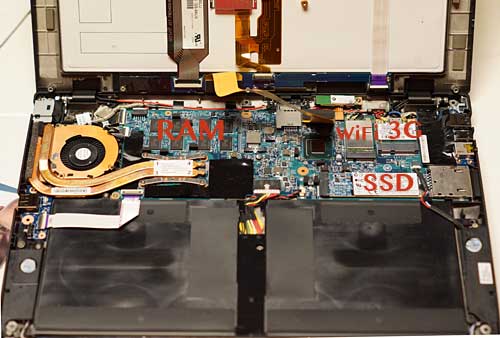
To access the internals, you'll need to remove 7 small Phillips head screws from the bottom, the open up the notebook and lift up the keyboard deck. |

